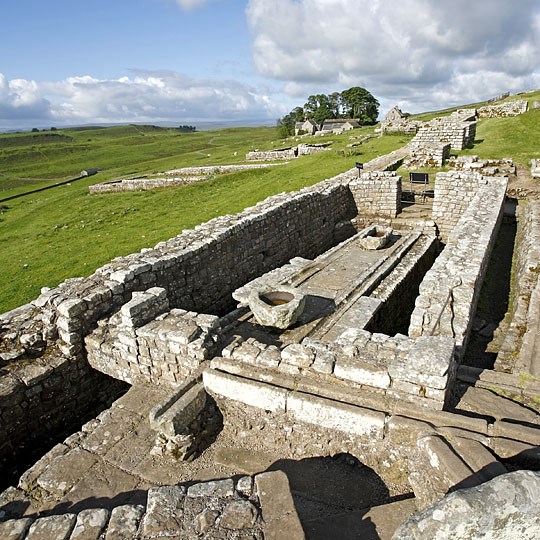Significance of Housesteads Roman Fort
The importance of Housesteads Roman Fort is greatly enhanced by its archaeological and landscape setting on the line of Hadrian’s Wall astride the Whinsill escarpment. Because of the fort’s isolation the archaeological remains have been little disturbed. The rich archaeological and epigraphic record ensures that the evidence from Housesteads remains central for all studies of the history and archaeology of the Roman occupation and for later periods.

State of Preservation
The remains at Housesteads are exceptionally well preserved, and include all the main buildings known from a Roman fort. Important remains are:
- the best-preserved stone-built latrines, cisterns and water channels of any Roman fort in Britain
- the headquarters building and commanding officer's house with stables
- two complete barrack blocks, which show evidence for radical changes in plan in the late 3rd century
- the double granaries with stone pillars that would have supported the raised floor
- the complete line of the fort's curtain wall and all four gates
- the civilian settlement outside the south gate
- the Knag Burn, a unique surviving example of a gateway through Hadrian's Wall
- extensive Roman and later field systems and terraces extending around the fort[1]
- a monumental late Roman stores building (building 15) with a small bath suite near the east gate
- the foundations of turret 36B, which was begun at the same time as the building of Hadrian's Wall (but before the fort).
Archaeological Investigation
Excavations throughout the 19th century, and especially by RC Bosanquet in 1898, provided evidence for the plan of the buildings within the fort.[2] In the 1930s further research outside the fort provided information on the civilian settlement alongside what was known about the remains of the military occupation.
Late 20th-century excavations resulted in more detailed knowledge of the barracks and other buildings in the north-east quarter of the fort.[3] Together, the results of this research and the excellent preservation of many of the remains of buildings ensure that Housesteads continues to be among the most intensively studied forts on Hadrian's Wall.
Inscriptions
The extensive record of inscribed stones known from Housesteads offers a detailed view of the religious and military life of the garrison, including dedications by German troops to their own deities.[4]
Archaeological Status
Housesteads was one of five Roman forts owned and excavated by John Clayton of Chesters in the 19th century. It was the centre of his 'Roman Wall Estate', one of the earliest examples of archaeological conservation in Britain.
Housesteads' reputation as one of the most popular Roman sites in Britain was maintained throughout the 20th century. When Housesteads was given to the National Trust in 1930 – the site is owned by the National Trust but maintained by English Heritage – the Illustrated London News described it as the 'crown of our chief Roman monument given to the nation'.[5]
READ MORE ABOUT HOUSESTEADS ROMAN FORT
Footnotes
1. HG Welfare, ‘Survey of Housesteads environs’, in A Rushworth (ed), Housesteads Roman Fort, the Grandest Station: Excavation and Survey at Housesteads, 1954–95, by Charles Daniels, John Gillam, James Crow and Others, 2 vols, English Heritage Archaeological Report (Swindon, 2009), vol 1, 235–49.
2. RC Bosanquet, ‘Excavations on the line of the Roman Wall in Northumberland, 1: the Roman camp at Housesteads’, Archaeologia Aeliana, 3rd series, 25 (1904), 193ff (accessed 10 Dec 2012).
3. Rushworth, op cit.
4. Ibid, 285–8.
5. Illustrated London News (18 Jan 1930), 84–5.